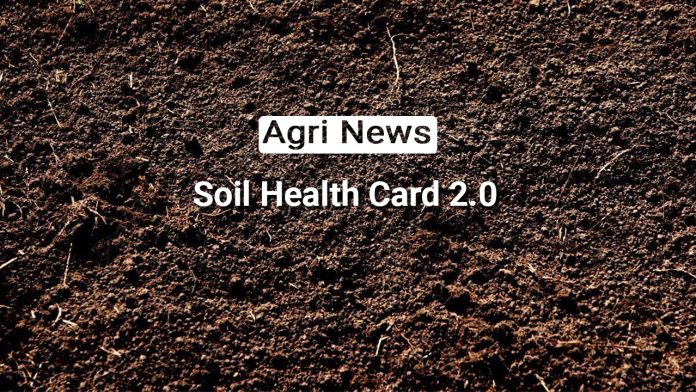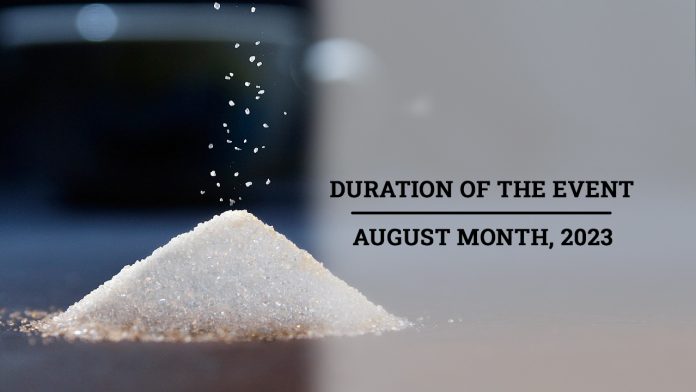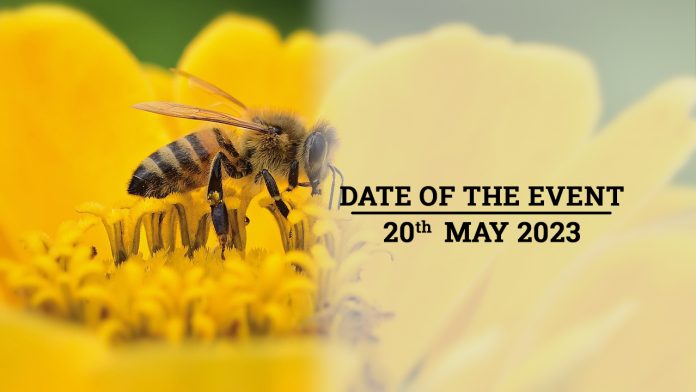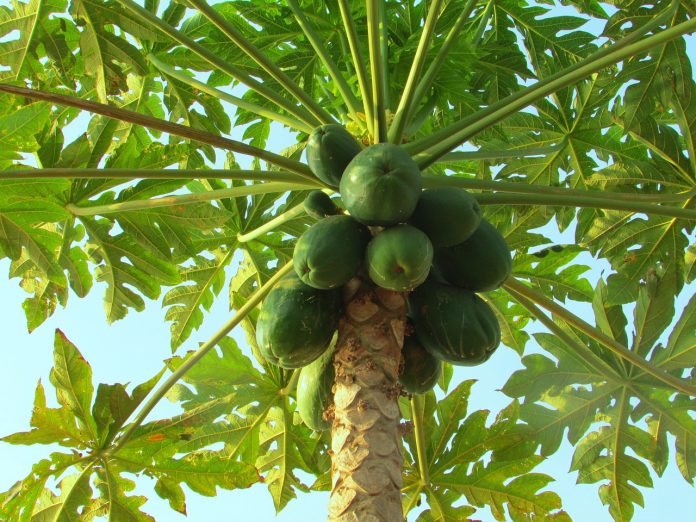Papaya (Carica papaya) is a tropical fruit, ideal for growing in kitchen gardens. Papaya is a rich source of nutrients such as vitamin C, vitamin A, minerals, and potassium. According to the Second Advance Estimate of the year 2020-21, the total area under papaya cultivation in India is about 1.48 lakh ha while total production is estimated to be about 5.88 million tonnes. In India, papaya is grown in Karnataka, Tamil Nadu, Andhra Pradesh, Kerala, Maharashtra, Gujarat, Uttar Pradesh and Bihar. The crop is generally easy to grow and maintain, high yielding, longer fruiting period and it can provide a good income for farmers. Get a full understanding of papaya cultivation and managing pests and diseases through this detailed article.
Papaya plants are woody tree-like plants that grow fast. The fruit is generally oval or pear-shaped and its flesh is juicy, sweet, and fragrant. The papaya tree is a fast-growing plant that can reach up to 10 meters in height. Papaya plants have separate male and female flowers that grow on different plants, a characteristic known as dioecious. They are highly dependent on pollination by insects to produce fruits. Some papaya types are hermaphrodites that produce both male and female flowers on the same plants which can self-pollinate. These hermaphrodite papaya types are more popularly used in commercial production.
Soil Requirement for Papaya Farming
A well-drained sandy loam soil with adequate organic matter is ideal for papaya cultivation. Soil pH can range from 6 to 6.5. Papaya plants have shallow roots and are highly sensitive to water logging. In the areas receiving heavy rainfall, if the drainage is poor, it may even cause the death of plants due to continuous drenching for 24 to 48 hours. Highly fertile soil with good drainage is more desirable for papaya cultivation.
Climate Requirement for Papaya Farming
Papaya is a tropical fruit that can grow well in warm and humid climates. It is highly susceptible to frost. The ideal temperature for papaya growth is 25 – 30°C. During winter, the night temperature below 12°C may severely affect the plant growth. Temperature below 10°C may inhibit plant growth, maturity, and ripening of fruits. A dry climate may induce sterility during flowering, but it contributes to adding sweetness to fruits during fruit maturity. It can grow in full sun but should be protected from wind and cold weather. Windbreaks can help to protect the plants from strong winds.
Buy the Best Varieties of Papaya Seeds in India
| Papaya Varieties/Hybrid |
Specifications |
| Red Lady Papaya Seeds |
- Brand: Known You Seed
- Tolerant to papaya ringspot virus
- Fruit weight ranges from 1.5 – 2 kg
- Bears fruit at 60-80 cm height
- Produces over 30 fruits/plant in each fruit-setting season
- Fruit flesh is thick, and red with a 13% sugar content
|
| IRIS Hybrid Papaya Seeds |
- Brand: IRIS hybrid seeds
- Suitable for all seasons
- Harvest time: 35 – 40 weeks
- Suitable for Home/Kitchen Garden
|
| URJA Madhuri Papaya Seeds |
- Brand: URJA seeds
- Soft and sweet fruit flesh
- On maturity, it turns to a bright reddish-orange color
- Average fruit weight ranges from 1.5 to 2.0 kg
|
| IRIS RC-315 Papaya Seeds |
- Brand: IRIS hybrid seeds
- Tall and vigorous type
- The fruit shape is oval
- Fruit weight: 1.5 – 2 kg
- Fruit maturity: 8 – 10 months
- Yellow colour fruit flesh
- TSS: 13 brix
|
| Sarpan Solo-109 Hybrid Papaya Seeds |
- Brand: Sarpan Seeds
- Fruit flesh is dark orange in color
- The plant bears 120-150 fruits per plant per year
- Harvest: 7-8 months after planting
- Gynodioecious plants & every plant bear fruit
|
| IRIS Hybrid Fruit Seeds Papaya RC-217 |
- Brand: IRIS hybrid seeds
- Medium tall and vigorous type
- The fruit shape is round
- Fruit weight: 2 – 2.5 kg
- Fruit maturity: 9 – 10 months
- Colour fruit flesh
- TSS: 13 brix
|
| Rise Agro Indus Honey Gold F1 Hybrid Papaya seeds |
- Brand: Indus seeds
- The fruit is reddish-orange in colour
- Fruit weight (kg): 2 – 2.5 kg
- Fruit maturity: 9 months after transplanting
- Suitable for long-distance shipping
- Tolerant to papaya ringspot virus
|
Seed rate of Papaya
Varieties: 200 gm/acre; Hybrid: 100 gm/acre
Propagation
Papaya is generally propagated through seeds. Fresh seeds from fully ripe fruits can be used. Papaya seeds may lose viability very quickly within 45 –60 days. To facilitate good germination, remove the mucilaginous coating of the seeds by rubbing them with wood ash. The seeds can be washed off and dried in the sun before use.
Papaya Seed treatment
Treat the seeds with Gibberellic acid at 1.25 ml/lit water to overcome dormancy and cause rapid seed germination and Bio fungicide at 10 ml/kg seeds or Carbendazim 50% WP at 0.5 – 0.8 gm/lit water to control fungal diseases like damping off, collar rot and stem rot.
Nursery
The seedlings can be raised in nursery beds or polythene bags.
- Nursery beds: Raised beds 3 m long, 1 m wide, and 10 cm high can be prepared. The treated seeds should be sown 1 cm deep in rows, 10 cm apart, and covered with fine compost. Light watering is to be done in the morning hours. Cover the beds with polythene sheets or paddy straw to protect the nursery from adverse conditions.
- Polythene bags: Polythene bags of 20 cm height and 15 cm diameter, 150 to 200 gauge can be used for raising seedlings. The bags should be filled with a 1:1:1 ratio of topsoil, FYM, and sand. Then, dibble 4 seeds per bag at 1 cm depth. These polythene bags should be kept in partial shade. Watering can be done using a rose can.
Planting Time of Papaya in India
June – September is the ideal season for planting papaya. But in Northeast areas, papaya can be planted from February to March to escape frost damage at fruiting time. Avoid planting during the rainy season.
Planting
The seedlings will be ready for transplanting in about 45-60 days. In a well-prepared field, pits of 45 x 45 x 45 cm sizes are to be made within the required distance. It should be filled with topsoil along with 20 kg of FYM and 1 kg of neem cake.
- In the case of Dioecious varieties, plant 1 male plant for every 12 – 15 female plants for pollination purposes.
- In the case of the Gynodioecious variety, plant one seedling per pit.
Give light irrigation after transplanting.
Spacing
Planting distance varies from variety to variety. Tall and vigorous varieties are planted at more spacing while dwarf or medium varieties are planted at closer spacing. Generally, 1.8 x 1.8 m of spacing is followed. However, for high-density planting, a spacing of 1.25 x 1.25 m is recommended which can accommodate 2590 plants/acre.
Fertilizer Requirement For Papaya Farming
The general NPK recommendation is 200:200:400 gm/plant/year
Note: Top dressing of NPK fertilizers should be done at an interval of 60 days during the vegetative and flowering stages as mentioned in the table. Apply fertilizers in a trench 20 – 30 cm away from the stem around the tree, then fill the soil.
| Nutrient |
Fertilizer |
Dosage |
Time of application |
| Organic |
FYM |
10 kg/plant |
Basal |
| Neem cake |
1 kg/plant |
Basal |
| N |
Urea |
108 gm/plant |
1st month after planting |
| 108 gm/plant |
3rd month after planting |
| 108 gm/plant |
Mid of 4th month after planting |
| 108 gm/plant |
6th month after planting |
| P |
Single Super Phosphate (SSP) |
626 gm/plant |
At the time of planting |
| 626 gm/plant |
3rd month after planting |
| K |
Muriate of Potash (MOP) |
250 gm/plant |
At the time of planting |
| 250 gm/plant |
3rd month after planting |
| 167 gm/plant |
6th month after planting |
| Zn |
Anand Agro Insta Cheal Zn 12% Micronutrient |
Foliar: 0.5 – 1 gm/lit water |
1st spray: 4th month after planting
2nd spray: 8th month after planting
|
| B |
Linnfield Boron 20% Micronutrient |
Foliar: 0.3 gm/lit water |
Papaya Irrigation Best Practices
Adequate irrigation is necessary to prevent drought and frost attacks. However waterlogging conditions should be avoided. Protective irrigation should be given to young papaya seedlings in the first year of planting. In the second year, irrigate the plants at 7 days intervals during summer and 10 to 15 days intervals during winter season, if there is no incidence of rain. During the summer season, maintain adequate soil moisture to avoid flower and fruit drops. Ring method, basin method, or drip irrigation are different types of irrigation methods for papaya. In the case of Ring and Basin methods of irrigation, we have to ensure that water doesn’t come in contact with the plant base.
Papaya Intercultural Operations
Weeding
In the first year, deep hoeing should be done to check the weed growth. Weeding should be done regularly, especially around the plants. Controlling weeds within 3 – 4 feet of the papaya plant is important for optimum plant growth and fruiting. Organic mulching using straw is highly recommended for weed control and soil moisture conservation.
Earthing up
Earthing up can be done before or after the onset of monsoon to prevent water logging conditions in the field and also to help plants stand erect. It can be after the 4th, 6th, and 8th months after planting the papaya seedlings.
Roguing of male plants
In dioecious papaya variety cultivation, only 10% of male plants in the orchard ensure good pollination. After flowering, rogue out the extra male plants.
Staking
To prevent the plants from lodging due to heavy wind or over-bearing of fruits, bamboo sticks or other sticks are used to provide support.
Fruit thinning
When 2 – 3 fruits occur in the same pedicel, keep only one healthy fruit to ensure proper development. Carefully remove the extra fruits from the pedicel.
Papaya Crop Protection Practices
Pests infesting papaya plants, damage symptoms, and its control measures:
| Pests |
Damage symptoms |
Control Measures |
| Green peach aphids |
- They suck sap from leaves and cause leaf curling and distortion
- Causes premature drop of fruits
- Vector for papaya ringspot virus
|
Chemical control:
|
| Whitefly |
- Yellowing, downward curling, and crinkling of leaves (vector for papaya leaf curl virus)
- Causes shedding of leaves
- Sooty mold development on leaf surface due to honeydew secretion
|
Chemical control:
|
| Red spider mite |
- The presence of white or yellowish speckles on the leaf
- Webbing of affected leaf surface
- Causes scaring on fruits
|
Chemical control:
|
| Root-knot nematode |
- Yellowing and shedding of leaves
- Premature drop of affected fruits
- Presence of galls on roots
|
- Select seedlings without root galls for transplanting
- Follow crop rotation
- Mahua cakes can be applied to control nematodes
- Mix well-decomposed compost with 2 kg of Multiplex safe root and broadcast in the field
Chemical control:
|
| Fruit fly |
- Larvae feed on the internal portion of semi-ripe fruits by puncturing
- Presence of decayed patches and oozing of fluids on affected fruits
- Infected fruits turn yellow and fall prematurely
|
- Dispose of the dropped-infested fruits
- Summer plowing to destroy pupa
- Use tapas fruit fly trap at 6 – 8 per acre
Chemical control:
|
| Mealybug |
- Presence of white cottony masses on leaf, stem, branches, and fruits
- Infected portions become shiny and sticky due to honeydew secretion which causes sooty mold development
|
Chemical control:
|
(Note: Please check the product’s description before application to know the right time of application)
Diseases affecting the papaya plant, damage symptoms, and its control measures:
| Diseases |
Damage symptoms |
Control Measures |
| Damping off |
- It is mostly common in nursery beds and causes the death of seedlings
- The stem may start to rot at the soil line
- Infected seedlings may start to wi
|
Chemical control:
|
| Powdery mildew |
- White or grayish powdery growth on the upper leaf surface, flower stalk, and fruits
- Severely infected leaves turn yellow or brown, curl, dry up, droop, and fall off
|
- Spray Pseudomonas fluorescence at 2.5 ml/lit water
- Spray fermented buttermilk (1:3 ratio of buttermilk & water) twice or thrice with 10 days interval
Chemical control:
|
| Anthracnose |
- Affects leaves, flowers, and fruits resulting in drop-off
- Small, black, or brown circular spots appear on leaves
- Infected fruits may develop dark, sunken lesions later covered with pinkish, slimy spore mass
- Withering and defoliation of leaves
|
Chemical control:
|
| Collar rot and stem rot |
- Sunken, water-soaked lesions appear on the base of the stem or around the collar region
- Stem may become soft and mushy due to the rotting of the internal tissues
- Infected area may turn dark brown or black and rot
- Yellowing of leaves, stunted growth
|
Chemical control:
|
| Papaya ringspot virus
Vector: Aphids
Transmission: Sap, grafts |
- Downward and inward curling of leaf margin, leaf distortion
- Mosaic pattern of light and dark green areas on leaves
- The presence of concentric circular rings on the fruit surface
|
- Do not grow cucurbits around papaya field
- Plant sorghum or maize as a barrier crop
- Spray Geolife no virus at 3 – 5 ml/lit water or
- Spray VC 100 at 5 gm/lit water or
- Spray Terra virokill at 3.3. ml/lit water
- To control vector aphids, look the measures mentioned in the above table
|
| Papaya leaf curl
Vector: Whitefly |
- Curling and crinkling of leaves
- Downward and inward curling of leaf margin
- Affected leaves become brittle, leathery, and distorted
|
- Do not grow tomato, or tobacco plants near the field
- Spray V-Bind Bio viricide at 2 – 3 ml/lit water
- Spray 2.5 ml/lit water of Multiplex General liquid Micronutrient which help to develop resistance to the disease
- To control vector whitefly, look at the measures mentioned in the above table
|
| Alternaria Leaf Spot |
- Small, circular, or irregular brown spots with concentric rings surrounded by a yellow halo on the affected leaves
- Defoliation of affected leaves
- Circular to oval black lesions on the fruit surface
|
Chemical control:
|
(Note: Please check the product’s description before application to know the right time of application)
Harvesting
The economic life span of papaya trees is 3-4 years. Harvesting of papaya too early or too late might increase the risk of postharvest physiological disorders. The papaya tree starts flowering and sets fruits in about 6 – 7 months. The fruits become ready for harvesting in 10 – 11 months from planting. Fruit ripening is indicated by the change in fruit color from green to yellowish green. Harvesting should be done by hand using sharp knives.
Harvesting indices:
- Fruit colour changes from dark green to light green with a slight tinge of yellow at the apical end
- Fruits can be harvested when the latex of the fruit becomes watery
Average Yield
Average yield per plant: 30 – 50 kg
Average yield per acre: 12 – 16 tons (1st year); 6 – 8 tons (2nd year)
Extraction of Papain
Papain is a proteolytic enzyme that is commonly extracted from papaya fruit and widely used in the meat, pharmaceutical, food, textile, and cosmetic industries. Here are the steps involved in the extraction of papain from papaya:
- For papain extraction, tapping of latex is done in mature fruits which are 70 – 90 days old from the fruit set.
- It should be done early in the morning before 10:00 am.
- Using a razor blade or sharp pointed bamboo stick, give four equally spaced longitudinal cuts/incisions from the stalk to the fruit tip. The depth of the cut should not be > 3mm.
- Tapping should be repeated on the same fruit four times at an interval of 3 – 4 days. Cuts should be made on places of fruit surface not covered previously.
- Collect the latex from the fruits in an aluminum tray and shade-dry it. Drying can also be done rapidly using an oven at 45 – 50°C temperature.
- Filter them using sieve mesh and then add 0.05% potassium meta bisulphite (KMS) to the latex to get better color and keep quality.
- Dried latex is powdered, sieved through the mesh, packed in polythene bags, and sealed.














